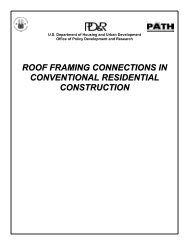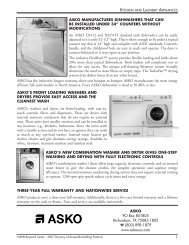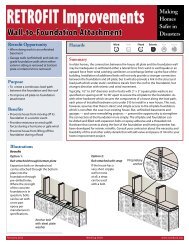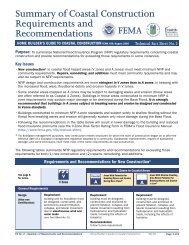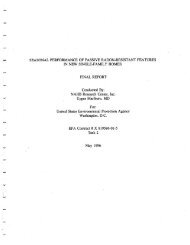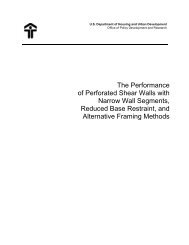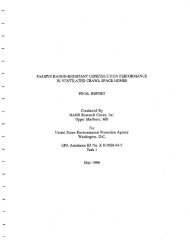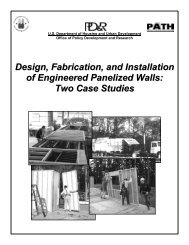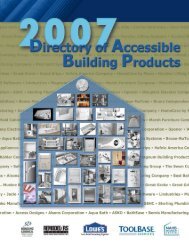The Rehab Guide, Volume 2: Exterior Walls - ToolBase Services
The Rehab Guide, Volume 2: Exterior Walls - ToolBase Services
The Rehab Guide, Volume 2: Exterior Walls - ToolBase Services
Create successful ePaper yourself
Turn your PDF publications into a flip-book with our unique Google optimized e-Paper software.
FIGURE 1LAPPED FLANGE3. INSTALL A CLEAR POLYETHYLENE VAPOR RETARDER.Most plastic barrier films are either clear polyethylene, black polyethylene, cross-laminated polyethylene, orreinforced polyethylene. <strong>The</strong> most basic of these materials, clear polyethylene, is also the most economical.Available in 4-, 6-, and 10-mil thicknesses, it is best suited for interior wall applications over framing and insulation.As clear poly’s content is up to 80 percent “reprocessed” material, it is also an environmentally sustainablechoice. <strong>The</strong> high recycled content comes at a cost: its quality can be uneven and it generally has poortear and puncture resistance. Clear poly should never be used for exterior applications or applications withmore than limited exposure to sunlight. Clear poly is available in widths of 4 to 32 feet in 100-foot long rolls.As with all polyethylene vapor retarders, for horizontal application over wood framing, staples are most oftenused. For maximum effectiveness, joints should be kept to a minimum and seams should be lapped and taped.ADVANTAGES: Relatively inexpensive and easy to install. In more severe heating climates, the use of interiorpolyethylene films is most effective and is practical where interior finish surfaces are removed. Beingtransparent, attachments to framing members are simplified, as is the installation of wallboard materialover the polyethylene, because the studs are visible.DISADVANTAGES: Limited tear and puncture resistance. Clear poly must be installed with care to avoid damage.All penetrations such as electrical junction boxes must be taped and sealed to ensure effectiveness. Clear polycan be used only in instances where wall finishes and surfaces have been removed, fully exposing wall framing.4. INSTALL A BLACK POLYETHYLENE VAPOR RETARDER.Black polyethylene is nearly identical to clear poly, except for the addition of carbon black to the compositionas a Ultraviolet inhibitor. This permits the use of the polyethylene where some limited exposure tosunlight is required, such as at exterior wall surfaces. Black polyethylene strength characteristics are similarto clear poly, with low tear and puncture resistance.ADVANTAGES: For exterior wall surface applications in hot, humid, cooling climates, black UV protectedpoly films can provide superior vapor retarder performance.DISADVANTAGES: Limited tear and puncture resistance. Unreinforced black poly must be installed with care toavoid damage. Its opaque nature makes installation more difficult by obscuring underlying framing, sheathing,and other components. Joints and seams must be lapped and taped for full effectiveness. Installation is limitedto conditions where siding has been fully removed and attachment directly to exterior sheathing can be made.345. INSTALL A CROSS-LAMINATED POLYETHYLENE OR FIBER-REINFORCEDPOLYETHYLENE VAPOR BARRIER.Compared with standard polyethylene, high-density cross-laminated poly and fiber-reinforced poly areboth specialty products manufactured for applications where higher strength is required. For retrofitting



